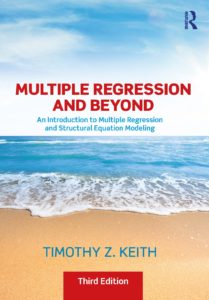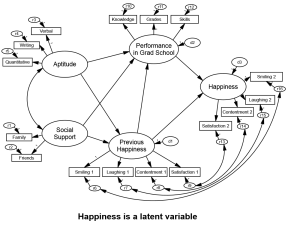(From the Routledge web page)
1. What inspired you to become a professor?
I had earned a Master’s degree in school psychology and was working as a school psychologist. It was a great job; I enjoyed working with kids, parents, and teachers. I knew at some point that I wanted to return to school for a PhD, however. I did, thinking that I would return to working in schools when I finished. But I discovered that as much as I enjoyed working in schools, I enjoyed doing research even more! That’s when I decided to become an academic, when I realized how much fun it was to be able to conduct research on topics that interested me.
2. What motivated you to write Multiple Regression and Beyond, 2nd Edition?
I was teaching classes in multiple regression and structural equation modeling and could not find textbooks I really liked. There were features I liked about several, but it seemed to me that many of them taught as if all students would understand how the methods worked by working through formulae. Certainly some students learn well that way, but many students simply wind up going through the steps without any real conceptual understanding of how the statistical methods they are using can answer questions they are interested in. I wanted to write a textbook that would reach a wider range of students, one that would explain the concepts both numerically and conceptually.
I was also using a great little data simulation program (DATASIM) and found that students really responded well when I had them analyze realistic examples for themselves; the material really seemed to click and they moved to a better understanding of how to use these methods to answer their own research questions.
Those two reasons were the genesis of my writing the original text. The first edition was very well received, and I was surprised but very gratified when I started getting comments from faculty and students around the world who used the text, thanking me for the practical examples, and the conceptual, practical explanations of MR and SEM. Wow! How could I not update it and improve it in a second edition?
3. What’s your favorite new feature in this edition?
It is hard to choose. All chapters are updated in the second edition. There are new examples, drawn from the research literature, that teach important points and concepts by having students analyze relevant data. There are new chapters introducing logistic regression and multilevel modeling from a MR perspective (to allow a smoother transition to these methods); latent means in SEM, invariance testing; and latent growth modeling in SEM.
I am especially pleased with the new chapter on the analysis of latent means in SEM. This is a topic that often confuses new SEMers; when I teach classes on SEM I often start this class with the tongue-in-cheek statement “OK, we’re finished with the easy stuff; now on to the hard stuff.” I think this chapter does a good job introducing this topic with an interesting example from the research literature: a true experiment in which hypnosis was used to treat hot flashes in breast cancer survivors.
4. How is this textbook different from other textbooks in the field?
It assumes that students will learn best by analyzing research-literature-derived real-world examples, combined with conceptually-oriented explanations. That plus the great beach scene on the cover! Here is an Amazon review from the first edition:
“As a doctoral student, I found this book extremely well-written, useful, and easy to understand. Includes real-world examples, which really help a new learner like myself get more comfortable with the concepts. Excellent.”
5. What is the most important thing you would like students and professors to take away from your book?
That they really can understand and conduct research using regression, CFA, and SEM to answer questions that intrigue them and others.
6. Can you tell us about the instructor/supplemental materials available with this book? What will students/instructors find the most helpful?
All these materials are on my website: www.tzkeith.com . All students have access to all the data sets used in the book, plus much of the computer syntax used to produce the output (currently SPSS for MR and Amos and Mplus for SEM; more to come). There is supplemental material for some chapters. For example, there is an explanation of additional coding method illustrated for Chapter 7, as well as some caveats for the material presented in that chapter; again, I will add to the materials, as well.
For instructors there is the output for all examples and exercises and some handouts they may find useful in class. I will be adding PowerPoints for all chapters in the near future. Also, I welcome suggestions from instructors and students about what other material would be helpful to include on the website or in the next edition.
7. What findings in writing/researching the book surprised you?
The explosion in the usage of SEM from when I wrote the first edition to now. It is used in so many disciplines, now, and much more widely. This is reflected in the variety of departments represented when I teach classes on these topics: architecture, business, communications, engineering, education, nursing, political science, psychology, and more. As a result, it was much easier to find great examples of SEM to include in the text from across a variety of disciplines!
8. What are some of the misconceptions of multiple regression (MR) analysis and structural equation modeling (SEM)?
The notion that MR is primarily used for prediction, rather than explanation; I think explanation is much more common. Although not a misconception, per se, I think many people do not realize how important it is to account for the important common causes of one’s presumed cause and presumed effect in both MR and SEM. These two ideas are related; if you have accounted for the important common causes, then MR and SEM work quite well for explanatory research. These are points that I return to repeatedly in the text.
Another underappreciated point (as opposed to a misperception) is how closely related these methods are conceptually. If you understand MR, you have the basis for path analysis, which is the simplest form of SEM. Add in CFA and you have the basis for understanding latent variable SEM. The simple concepts of slopes and intercepts from MR really help in the transition from SEM to latent growth modeling.
9. If you had to choose 5 words to define your writing process, which would you choose?
Painful, yet gratifying. Illuminating, educational, revealing (to me…hopefully to others, as well).
10. Describe your philosophy of teaching and learning in one sentence?
Explain and illustrate research and statistical concepts several different ways because not everyone learns the same way.
11. What was the proudest moment of your career so far?
Wow…it is tough to pick a single moment. Publishing this book is certainly one of them.
Receiving Division 16 of APA’s senior scientist award is certainly one of them as well.
But then so is every moment I see a student’s face light up with the realization that he or she has just understood something that was previously confusing.
12. What is your favorite social media platform and why?
I’m pretty backward when it comes to social media. Basically I use Facebook to post photos from various BBQ joints in Texas. For all book related stuff see tzkeith.com.
13. Please tell us your favorite thing about education in one word.
Renewal.
Timothy Z. Keith, PhD
I am a professor of Educational Psychology and the program director of the School Psychology programs at the University of Texas, Austin. I have taught courses and conducted workshops on the topics covered in this book for more years than I want to advertise here! Here is my UT faculty profile.
My research focuses on the nature and measurement of intelligence and understanding the influences on school learning. I have continuing methodological interests in using multiple regression analysis, structural equation modeling, and confirmatory factor analysis, and regularly teach classes on these methods.



